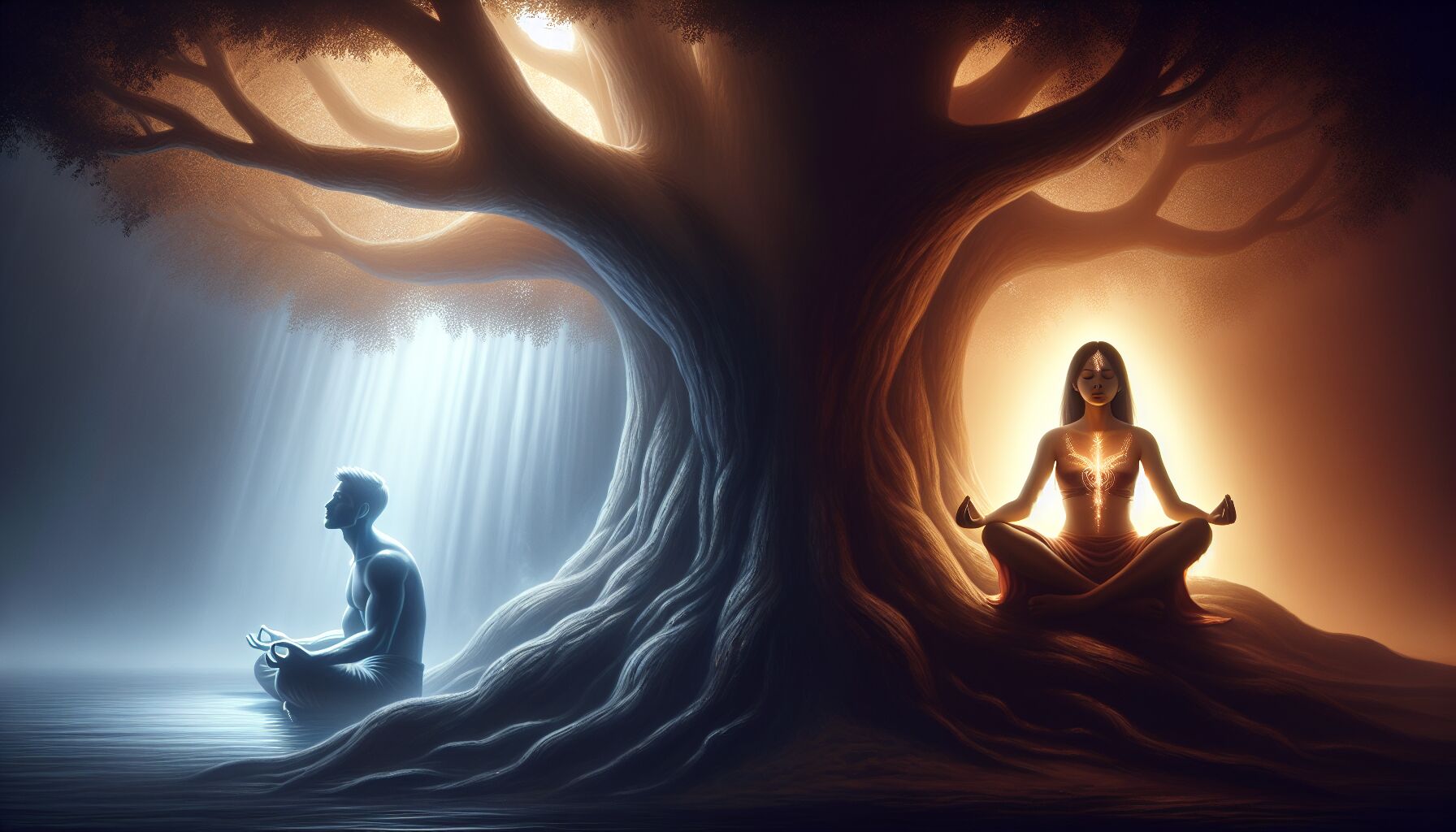 The higher self, often referred to as our true essence, is that part of us whispering wisdom amidst life’s chaos. Have you ever wondered about that quiet nudge leading you to act with love or compassion, even when no one’s watching? That’s it — your higher self gently steering you. While this might sound lofty, think of it as the part of you tethered to a deeper truth, the intuitive compass pointing toward what truly matters.
The higher self, often referred to as our true essence, is that part of us whispering wisdom amidst life’s chaos. Have you ever wondered about that quiet nudge leading you to act with love or compassion, even when no one’s watching? That’s it — your higher self gently steering you. While this might sound lofty, think of it as the part of you tethered to a deeper truth, the intuitive compass pointing toward what truly matters.
When tuning into this aspect, we’re essentially diving into self-awareness. Imagine peeling back layers of assumptions and discovering the core values that genuinely resonate with your spirit. Here’s the thing — your higher self doesn’t scream for attention; it speaks with the serene confidence of ocean waves, knowing its place and purpose without fanfare. This voice doesn’t demand your recognition; instead, it patiently waits for you to turn down the noise and listen.
Recognizing one’s higher self is also about discernment. In a world cluttered with voices and opinions, identifying the one that aligns with your highest good can feel like searching for a single quiet star in a vast night sky. But here’s something to chew on: every time you act selflessly or extend kindness without expectation, you strengthen this connection, enhancing your spiritual growth.
Albert Einstein once remarked, “Strive not to be a success, but rather to be of value.” The higher self embodies this idea, urging us to see and serve the larger picture — to use discernment to differentiate between fleeting success and lasting fulfillment. You start to notice subtle shifts when led by this inner guide. Like trusting an old friend you’ve known forever, decisions become clearer and less fraught with doubt.
Our higher self isn’t separate from us; it’s integrated into our everyday experiences, waiting for acknowledgment. By embracing practices that cultivate mindfulness and reflection, like meditation or simply pausing occasionally to breathe, you tap into this ever-present well of inner wisdom. You know what? It’s somewhat magical — but not in an ethereal, untouchable way. It’s the magic of being authentically you, of following a path that feels not only right but necessary.
So, how do we harness this connection? Start small. Journaling can serve as a powerful practice, offering a mirror to your soul’s whispers. Engage with nature — it’s grounding and reminds us of the interconnectedness we sometimes forget. Even a walk in a local park can become a cathedral for quiet contemplation.
Ultimately, recognizing your higher self isn’t about some grand transformation or mystical revelation. It’s about everyday choices grounded in love and guided by an informed inner knowing. Just consider this path as one where the journey itself enriches and enlightens, rather than rushing towards a destination.
By fostering this relationship, you’re not only moving toward self-awareness but also nurturing a presence that influences those around you. That, in itself, changes the world more than any loud proclamation could. So listen closely, with intent and tenderness. Your higher self has stories to share and wisdom to impart — it’s time to write your truth.
Recognizing the ego
Recognizing the ego’s voice amidst the cacophony of daily life can sometimes feel like trying to isolate a raindrop in a downpour. Have you noticed that sharp, judgmental inner monologue? Often, that’s the ego, clamoring for attention, approval, and superiority. It speaks louder than our higher self, almost like a megaphone blasting in a quiet room. This voice is rooted in fear, driven to protect what it believes is a fragile identity — ever chasing validation from others.
Here’s the thing: the ego thrives on comparison and separation. It craves being better, smarter, or more successful than others, leading to a cycle of dissatisfaction and frustration. It’s that gut-wrenching feeling when scrolling through social media, seeing someone else’s highlight reel and feeling “less than.” It’s almost like the ego is constantly playing a game of one-upmanship — but who really wins that game, anyway?
You might wonder, “How can I tell when it’s the ego talking?” Well, when phrases seep into your thoughts like “I need to prove myself” or “They don’t appreciate me enough,” it’s often the ego at work, hungry for external affirmation. This mindset can overshadow genuine connection and self-awareness, creating a false narrative about who we are and what truly matters. It’s almost like wearing a mask that slowly becomes suffocating.
Yet, recognizing this aspect doesn’t call for disdain or judgment towards oneself — quite the opposite, actually. Cultivating spiritual growth is about observing the ego without attaching to its wants. Through practices like mindfulness, we can watch our thoughts like clouds passing by, realizing they don’t define us. It’s in this realization that true freedom lies.
Curiously, some of history’s greatest thinkers have grappled with this balance. As Oscar Wilde once pondered, “Be yourself; everyone else is already taken,” hinting at the futility of the ego’s perpetual quest to be someone it’s not. So, what can you do to step back from the ego’s grasp? Consider moments of gratitude and service — acts that remind us of our shared humanity rather than our separateness.
A trusty method some folks employ is intentional solitude, where you carve out time to sit quietly, perhaps in nature or a cozy spot at home, allowing yourself to tune into the breath and the present moment. It’s like hitting pause on the ego’s incessant playlist.
By practicing discernment and acknowledging the ego without judgment, it gradually loses its tight grip. You start seeing life not through a veil of competition but through a lens of camaraderie and understanding. Isn’t that a more compassionate way to move through the world? Share a smile with someone you pass on the street, and remember — we’re not as separate as the ego would have us believe. Here’s to the quieter, more meaningful connections we build as we listen beyond that pesky voice.
Differentiating between the two voices
 In the dance between the higher self and the ego, discerning which voice is speaking to you can be both enlightening and bewildering. But worry not, it’s not as complicated as it seems. First off, ask yourself this: Are your thoughts rooted in peace or pressure? The higher self approaches with calm assurance, offering guidance without expectation. It’s like opening a favored book—comforting, familiar, and full of insights that stretch beyond surface-level noise.
In the dance between the higher self and the ego, discerning which voice is speaking to you can be both enlightening and bewildering. But worry not, it’s not as complicated as it seems. First off, ask yourself this: Are your thoughts rooted in peace or pressure? The higher self approaches with calm assurance, offering guidance without expectation. It’s like opening a favored book—comforting, familiar, and full of insights that stretch beyond surface-level noise.
Conversely, the ego often utilizes fear and urgency to drive you forward. It insists on having the last word, craving applause and validation. The ego’s voice might sound like an insistent drumbeat, pushing you to make choices based on societal approval rather than personal fulfillment. In contrast, the higher self gently nudges you toward decisions that align with your true essence—with values that resonate with your core.
Here’s how you can tell them apart: the higher self speaks in whispers of compassion and understanding, like a gentle breeze reminding you of interconnectedness. It prioritizes spiritual growth and self-awareness. The ego, however, bellows in demands and comparisons, often leaving you feeling isolated. Consider this—a decision made in haste and filled with regret is often ego-driven, while a choice grounded in reflection and heart resonates with the higher self.
American author Helen Keller once said, “The best and most beautiful things in the world cannot be seen or even touched—they must be felt with the heart.” This speaks to the heart-centered wisdom of the higher self. When you base your actions on love and discernment, you lean into a realm of possibility where growth thrives over judgment, allowing you to truly embrace the present moment.
But how do you start recognizing these voices in your day-to-day life? Begin by cultivating moments of quietude. Engage in activities that switch off autopilot and welcome mindfulness. Meditation, journaling, or simply sitting in silence can create a sanctuary for your higher self to emerge. These practices plant the seeds of self-awareness, helping you step back from the mind’s busyness and tune into what truly matters.
So when you find yourself caught in the swirling dialogue between ego and essence, remember to breathe. Pause, reflect, and choose with intention. Acknowledge the ego’s presence without letting it steer the ship. By fostering these moments of clarity and connection, you empower your higher self to rise above the din, leading you towards decisions that honor your innermost truth. Embrace this gentle unfolding—it’s a journey worthy of the soul’s exploration.
 DS Haven In Light Of Things
DS Haven In Light Of Things






